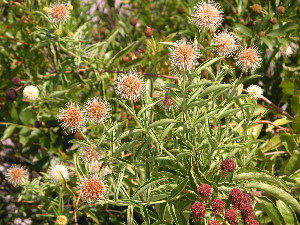Buttonbush
Cephalanthus occidentalis L.
Rubiaceae Madder Family
A shrub or small tree, buttonbush is characterized by very straight, unarmed and opposite branching stems, glossy leaves, and beautiful globe-shaped flowers. The flowers, which are white, pink, or yellow, resemble star bursts. Buttonbush grows throughout most of Texas, but it is confined to waterways and lakes or swamps, and canyons with springs or streams (Correll and Johnston 1970). Many native peoples in the American Southwest and Southeast have used buttonbush bark, foliage, and root for medicine.
Archeological occurrence. Buttonbush stems have been recovered from a Late Archaic context at Hinds Cave (Dering 2001). There are no other reports of buttonbush from archeological sites, however, most of the applications for buttonbush are medicinal, and medicinal uses are difficult to detect in material remains.
Medicine. Buttonbush has been used by several groups across North America for several therapeutic applications. It contains the bitter glycosides cephalanthin and cephaletin as well as tannins. As a result, buttonbush, like many medicinal plants, is often listed as a poisonous plant. The leaves, especially when wilted, are toxic to domesticated animals (Muenshcher 1950).
Modern-day herbalists note that the glycosides in buttonbush apparently stimulate the digestive system, causing the release of hydrochloric acid and enzymes. They caution that individuals with ulcers should not use this plant (Kane 2006). The downside to the use of this plant is that it clearly has potent poisonous qualities. The bark contains an abundance of cephalanthin, which affects most vertebrates, both cold and warm-blooded, destroys red blood cells, and is an emetic, spasmodic, and eventually produces paralysis (Felter and Lloyd 1898).
Native Americans harnessed these qualities and utilized the bark for a variety of ailments. Regarding digestive ailments, a strong decoction of the bark was used for dysentery (Campbell 1951). Along these same lines, the Meskwaki used the bark as an emetic (Smith 1928). The Seminole reported that they used the bark decoction as a cure for constipation, as well as diarrhea. This apparent contradiction may be explained two ways. First, it is possible that varying dosages present varying effects. The modern herbalist reports the calmative effects and mild laxative effects of very light doses of buttonbush leaf decoction. It is, however, also possible that the emetic effects of heavy doses of bark decoction are perceived as a curative for the problem, in the sense that if one clears the system, the problem goes with it. Camazine and Bye (1980) note this approach for the Zuni: "The Zuni expect that a traditional remedy for stomach-ache will induce vomiting. Whether or not the remedy truly cures the patient (from our Western medical viewpoint) is not of sole importance. The remedy will be regarded as effective if it causes the patient to vomit" (Camazine and Bye 1980:381). Thus, when one is operating outside of the Western medicine paradigm, the same plant may be used both as an emetic and as a cure for nausea, but for the express purposes of emesis. I include this somewhat paradoxical treatment (to our minds, anyway) as a cautionary note.
Among Indians in the American Southeast, the Seminole also utilized the plant to treat urinary blockage, apparently either stones or swollen prostate. The Choctaw and the Chickasaw used a poultice made from the roots for eye problems. A decoction made from the bark was used as an eye bath by the Choctaw (Taylor 1940). The Choctaw used the root bark and stem bark in an unspecified manner to treat fevers (Campbell 1951). The Choctaw also obtained relief from toothaches by chewing the bark, of buttonbush.
In conclusion, buttonbush foliage and bark contain very active and bitter glycosides that can cure or harm. Clearly the native peoples experienced in utilizing nature's medicine chest wisely used this plant to treat a variety of aliments, but the inexperienced should seek the assistance of a professional herbalist.
References:
Camazine, Scott and Robert A. Bye
1980 A Study Of The Medical Ethnobotany Of The Zuni Indians of New Mexico. Journal of Ethnopharmacology 2:365-388.
Campbell, Thomas N.
1951 Medicinal Plants Used by Choctaw, Chickasaw, and Creek Indians I the Early Nineteenth Century. Journal of the Washington Academy of Sciences 41(9):285-290.
Correll, Donovan S. and Marshall C. Johnston
1970 Manual of the Vascular Plants of Texas. Contributions from the Texas Research Foundation, Volume 6. Renner, Texas.
Dering, J. Philip
2001 Plants identified from Area F, Hinds Cave. Unpublished manuscript on file at Shumla Archeobotanical Services. Comstock, Texas.
Felter, Harvey W. and John U. Lloyd
1898 King's American Dispensatory, Eighteenth Edition, Third Revision, Two Volumes. Ohio Valley Co., Cincinnatti. Available online at www.henriettesherbal.com/eclectic/kings/. Accessed 05/07/07.
Kane, Charles
2006 Herbal Medicine of the American Southwest. Lincoln Town Press. Tucson, Arizona.
Muenscher, Walter C.
1950 Poisonous Plants of the United States. MacMillan. New York.
Smith, Huron H.
1928 Ethnobotany of the Meskwaki Indians. Bulletin of the Public Museum of the City of Milwaukee 4:175-326.
Taylor, Lydia A.
1940 Plants Used as Curatives by Certain Southeastern Tribes. Botanical Museum of Harvard University. Cambridge, Massachusetts.
![]()
